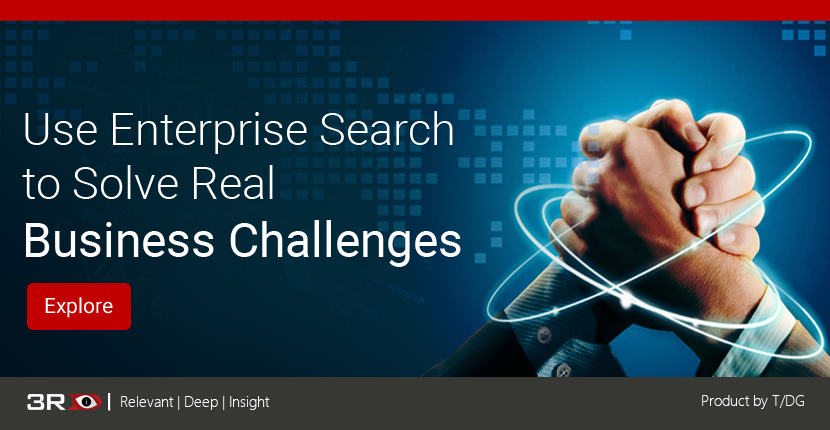
Solving Real Business Challenges with Enterprise Search
Enterprise search has come a long way and the enterprise search you have today is a far cry from the enterprise search that came into being in the early '90s. Today, there are a host of technologies that have made their advent into the world of enterprise search, only to make it better and more effective. Semantic search, artificial intelligence, and Natural Language Processing (NLP) are just some of the breakthrough technologies that have redefined search for us.
Today, you have enterprise search tools that have all it takes to understand the user and his intent behind the search in order to ensure that only the most relevant search results are presented to the user. A new age enterprise search tool like 3RDi Search is a testimony to the immense advancements in this field as it is power-packed with every search, text analysis and text mining feature you could think of. Needless to say, the enterprise search tool, as we know it today, is the solution to every challenge related to data analysis that businesses face today. In this article, we shall look at a few challenges that are real for businesses across the globe and how an effective enterprise search software can come to their rescue.
Challenge #1: Untapped Potential of Unstructured Data
Enterprises today have to deal with an unsurmountable volume of unstructured data that is ever on the rise. Data gets accumulated from varied sources, including emails and social media, and is present in varied formats. This potpourri of information can be really useful for an organization in so many ways but the biggest challenge lies in analysing it to recover the insights hidden within. In the absence of efficient search tools, the huge potential of this data is lost, as the conventional search approach is of little effect against unstructured data.
The Solution: The modern enterprise search platforms hold the key to tapping the potential of unstructured data with semantic search technology. Semantic search classifies the unstructured data into entities with relations between them, and also extracts facts, events and attributes, through a series of steps and is what you need to give structure to unstructured data and "read" it for actionable insights.
Challenge #2: Inaccurate and/or Irrelevant Search Results
Conventional search can only go as far as matching the keyword/query entered by the user and fetching the results on the basis of a keyword match. However, this is not always enough as there is a possibility of missing out on results that are relevant yet are not optimized with the particular keyword. On the other hand, it may also end up showing multiple results that might contain the keyword in a different context altogether, thus reducing the relevancy of search.
The Solution: This challenge can also be overcome with the semantic search and natural language processing technologies, which analyze the semantic meaning of the query as well as the intent of the user, before showing the results. The results can be dramatically different from that of a simple keyword search and this can be illustrated with a simple example. When you type the query 'apple' in the Google search box, what do you see? You see results related to Apple Inc. because Google, using its semantics based algorithms, determines that it is highly likely that the user is looking for information about the company as opposed to the fruit by the same name. So, you get relevant results with little noise or spam entries.
Challenge #3: Scattered Data that is Constantly Growing
The data an organization has today not just consists of varied formats, but also is unorganized and scattered as it comes from varied sources. Managing the enormous volumes of data and integrating them effectively for easy analysis is one of the major challenges that enterprises are facing today. Add to it the fact that this data is constantly growing, and it can become a task of Herculean proportions!
The Solution: A new age enterprise search tool like 3RDi Search is designed for effective data integration so that organizations have no longer to worry about managing diverse forms of data. Be it data in the form of emails, graphs, news feeds, social media or images, enterprise search tools today are equipped to handle it all. These tools are equipped with plug-ins that perform the function of collecting the data from different sources and merging them into your vocabulary. The effective data integration resulting from this can make it easy for organizations to manage data and tap into for useful insights.
Challenge #4: Little Information about User Search Behaviour
The search log of an enterprise search tool holds the key to search patterns of users as well as many other useful information about user's search behavior. However, skimming through the seemingly endless logs to look for information that is of importance, is an exercise that requires a lot of effort and time and is near impossible to accomplish manually. As a result, organizations fail to tap into the potential of this data and derive insights from it.
The Solution: The search analytics feature we have in the enterprise search tools today provides real time powerful analytics that can help businesses unlock the potential hidden within the search logs. The data derived from analytics can be used in informed and intelligent decision making for the business. Also, data derived from search analytics can be used by enterprises to closely study what users want and then use it to create a personalized search experience for the user.
The Final Word
There are many ways in which the modern enterprise search tool can help organizations overcome their challenges and meet their business goals. In addition to providing effective solutions to challenges we discussed above, the new age enterprise search tools work in many ways to create an enhanced search experience for the users.